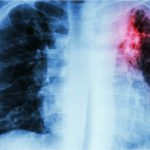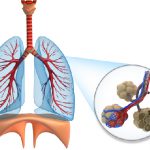What is lung cancer diagnosis?
The diagnostic tests used for lung cancer can vary from patient to patient. There are also numerous other factors that doctors look into while diagnosing a patient such as medical history, symptoms, and findings from previously conducted physical examinations. Enlisted below are a few tests recommended for lung cancer diagnosis.
Common diagnostic methods for lung cancer:
Imaging tests
Imaging tests are essential for lung cancer diagnosis. They help doctors understand the location of the tumor, the grade of metastasis, treatment outcomes, and they help predict cancer recurrence. Listed below are various imaging tests:
Computed tomography (CT)
In this kind of an imaging method, X-ray machines project a cross-sectional view of the lungs on a cmputer. CT is the most commom as the images produced are of good quality, and the detection of abnormalities are up to 90%.
Positron emission tomography (PET) scan
In a PET scan, the a type of radioactive sugar is injected into the patient’s bloodstream. Since the cancer cells consume large amounts of sugar quickly, a camera is spots this kind of radioactivity. More importantly, this type of imaging test helps understand if cancer has spread to other parts of the body.
Other procedures used in the diagnosis of lung cancer
Doctors collect tissue or fluid from around the lungs and carefully test it to see if cancer cells are present in the lungs. The tests are:
Sputum cytology
Sputum cytology is a diagnostic test in which you pathologist studies a sample mucus containing blood under a microscope to check for the presence of abnormal cells.
Bronchoscopy
Doctors use the process of bronchoscopy to usually check if there is a tumor or fluid in the lungs. A bronchoscope (a tube) passes through the nose or mouth and into the lungs.
Mediastinoscopy
Mediastinoscopy is a kind of endoscopy in which a surgeon incises the base of the neck. Surgical tools are inserted behind the breastbone to take tissue samples from the lymph nodes.
Fine needle biopsy (FNAC)
Firstly, in a needle biopsy test, a fine needle scrapes off cells from the affected area. A pathologist then examines these cells under a microscope to see if they are cancerous.
Biopsy
In a biopsy, doctors remove some tissue and study it under a microscopea and pathologist identifies if it is cancerous or not. There are other tests that can suggest if the tissue is cancerous, but a biopsy is a more definitive method. Moreover, it is a standard gold test for cancer diagnosis.
Besides that, doctors recommend a biopsy after a USG or CT scan or along with bronchoscopy or mediastinoscopy.




